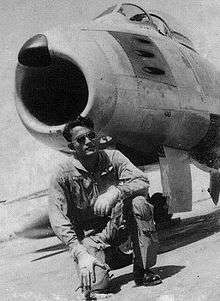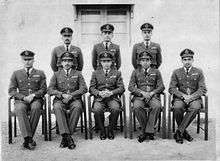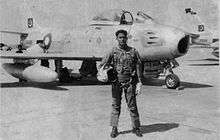Waleed Ehsanul Karim
Flying Officer Waleed Ehsanul Karim (Bengali: ওয়ালীদ এহসানুল করিম, Urdu: ولید احسان الکریم) (1 July 1944 – 19 April 1965) was a fighter pilot in the Pakistan Air Force and one of the youngest F-86 Sabre jet pilots in the world.[1]
Waleed Ehsanul Karim | |
|---|---|
 Flg. Officer Waleed kneeling in front of his North American F-86 Sabre jet fighter, c. 1964 | |
| Born | 1 July 1944 Harbang, Cox's Bazar, British India |
| Died | 19 April 1965 (aged 20) Arabian Sea |
| Allegiance | |
| Service/ | |
| Years of service | 1963 - 1965 |
| Rank | |
| Service number | PAK-4362 |
| Unit | 17th Squadron (The Tigers) |
| Battles/wars | Indo-Pakistani War of 1965 |
| Signature | |
Background
Waleed Ehsanul Karim was born on 1 July 1944 to Fazlul Karim and Nazmunnisa Chowdhurani in Harbang, Chakaria, Cox's Bazar, British India (later East Pakistan, now Bangladesh). He completed his Senior Cambridge (GCE) from PAF Public School Sargodha (formerly PAF College Sargodha) in April 1961 (5th Entry, Sabre House) and joined the Pakistan Air Force (PAF) in August 1961.
PAF career
He was commissioned in the PAF on 22 June 1963 in the 36th GD(P) Course with the service serial number of Pak-4362 and being the Wing Under Officer, was a candidate for the Sword of Honour at this time, but did not end up receiving it. In a vehement debate at the PAF Academy in Risalpur, Waleed passionately pushed the agenda of the Language Movement of 1952 which compelled the Government of Pakistan to establish Bengali as an official language on par with Urdu and English (the official and mainstream languages in West Pakistan). He was later nominated and became known as the captain of the basketball team at the academy. Flight Lt. Matiur Rahman (later recipient of the Bir Sreshtho in the Bangladesh Liberation War) and Air Vice Marshal Momtaz Uddin Ahmed were his classmates in both Sargodha and Risalpur.


Fighter pilot in the PAF
After his commission, Waleed was posted with the No. 2 Squadron at PAF Base Masroor in Karachi. After successfully completing Jet Conversion Training on T-33 jet trainers, he was designated for a Fighter Conversion Training Course with the North American F-86 Sabre (a relatively new aircraft being delivered by the United States to Pakistan since the late 1950s), following which he was posted with the No. 19 Squadron in Peshawar due to his strong performance.
Waleed was famous among personnel in the PAF for the daring stunts he performed with his F-86 Sabre and took part in the Republic Day flybys in Rawalpindi on 23 March 1965 as a wingman alongside Air Marshal Asghar Khan (then Chief of Air Staff of the Pakistan Air Force) and Air Commodore Zafar Chaudhry in Lockheed F-104 Starfighters.
Indo-Pakistani War of 1965
Waleed died when his aircraft (which was hit by anti-aircraft guns in the Rann of Kutch during a sortie by Indian forces early in the morning) had serious engine trouble and rapidly plunged into the Arabian Sea about 10–15 miles off the southern coast of Karachi on the night of 19 April 1965 as he was returning to Karachi from a reconnaissance mission over Gujarat, India. He had engaged the Indian Army in skirmishes throughout the Rann of Kutch by dropping smoke bombs during the daytime to screen infantry attacks. Neither his body nor his aircraft were recovered, but a part of the rudder from the Sabre was found about two months after and retrieved near the location where his aircraft crashed. He was a fighter pilot with the 17th Squadron (The Tigers) of the Pakistan Air Force when he died, and Air Marshal Azim Daudpota was his squadron leader at the time.
References
- Bowman, Martin (30 January 2016). Cold War Jet Combat: Air-to-Air Jet Fighter Operations 1950-1972. Casemate Publishers. ISBN 9781473874626.